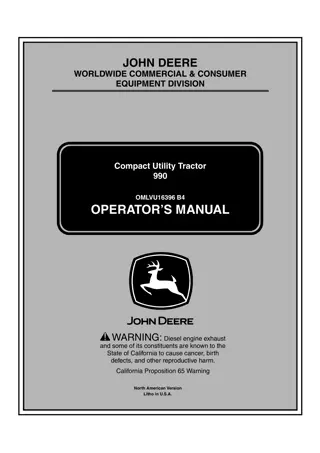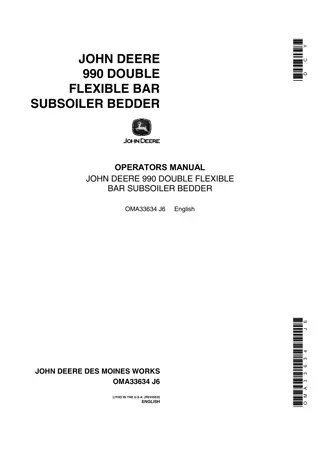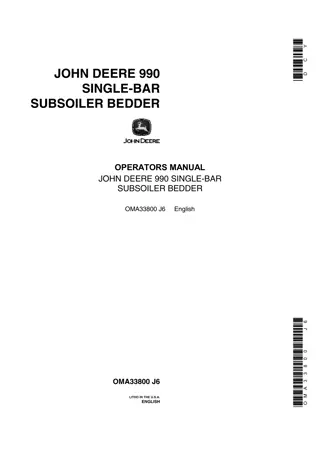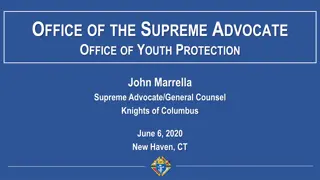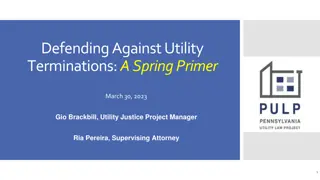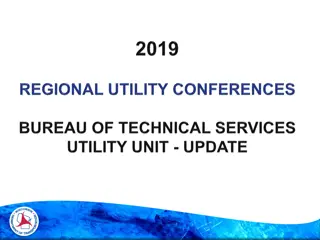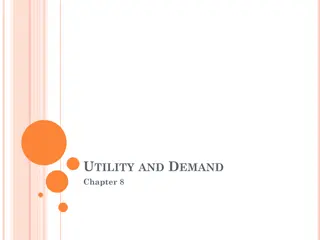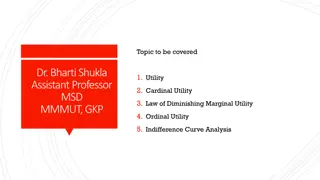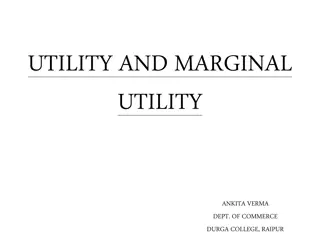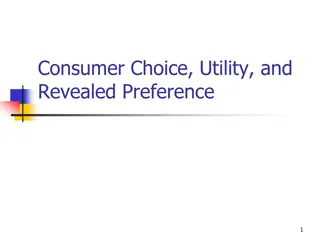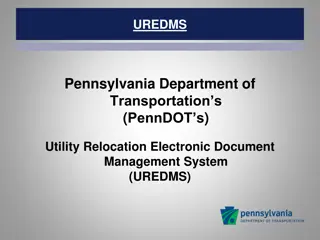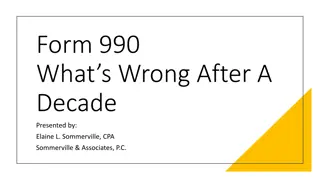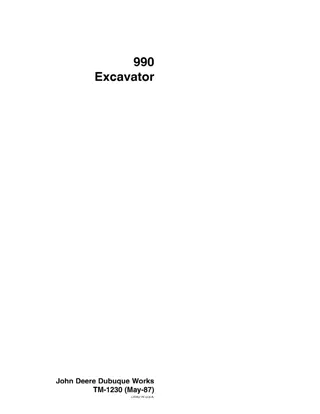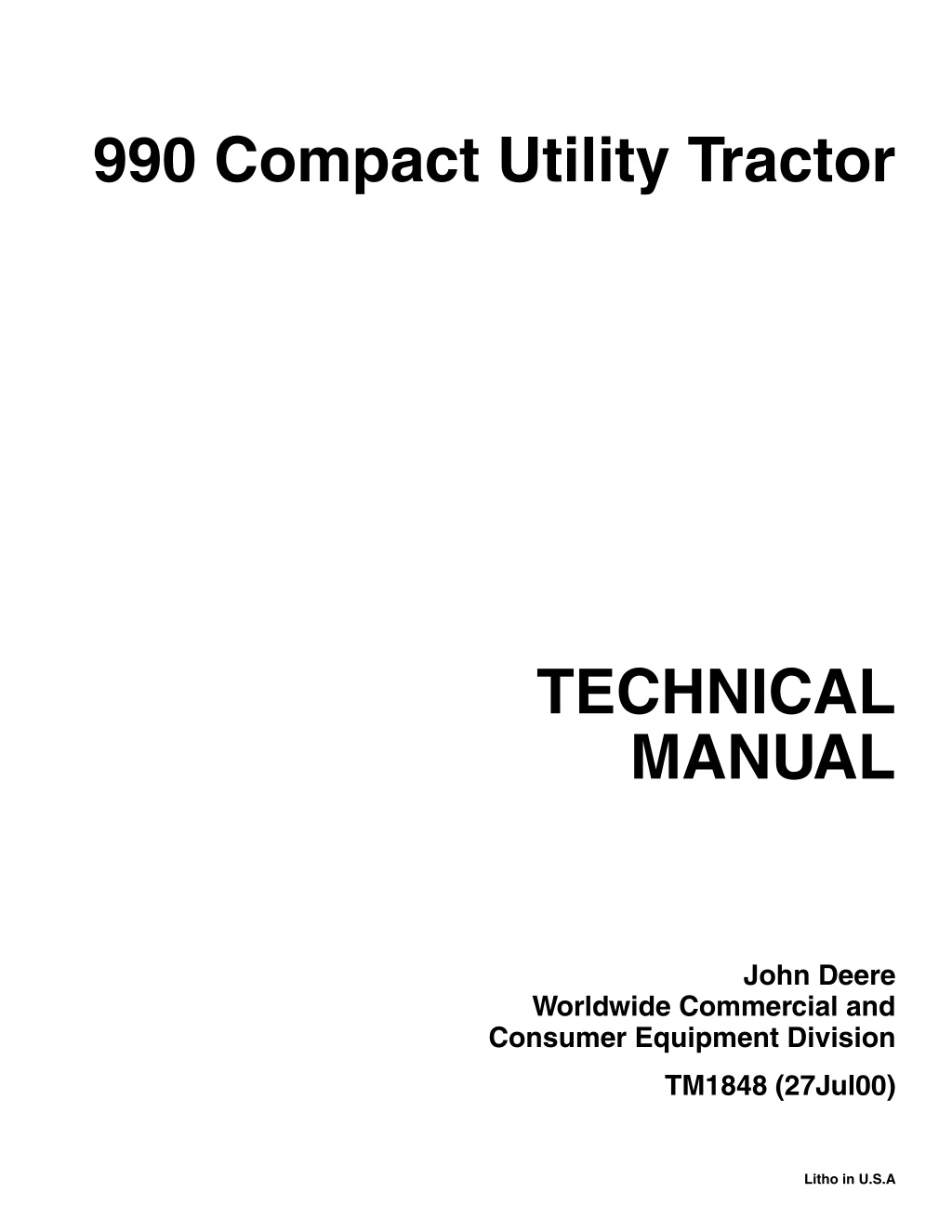
John Deere 990 Compact Utility Tractor Service Repair Manual Instant Download (TM1848)
Please open the website below to get the complete manualnn// n
Download Presentation

Please find below an Image/Link to download the presentation.
The content on the website is provided AS IS for your information and personal use only. It may not be sold, licensed, or shared on other websites without obtaining consent from the author. Download presentation by click this link. If you encounter any issues during the download, it is possible that the publisher has removed the file from their server.
E N D
Presentation Transcript
990 Compact Utility Tractor TECHNICAL MANUAL John Deere Worldwide Commercial and Consumer Equipment Division TM1848 (27Jul00) Litho in U.S.A
INTRODUCTION This technical manual is written for an experienced technician and contains sections that are specifically for this product. It is a part of a total product support program. Safety Specifications and Information The manual is organized so that all the information on a particular system is kept together. The order of grouping is as follows: Table of Contents Specifications Component Location System Schematic Theory of Operation Troubleshooting Chart Diagnostics Tests & Adjustments Repair Diesel Engine Electrical Power Train Note: Depending on the particular section or system being covered, not all of the above groups may be used. Each section will be identified with a symbol rather than a number. The groups and pages within a section will be consecutively numbered. We appreciate your input on this manual. To help, there are postage paid post cards included at the back. If you find any errors or want to comment on the layout of the manual please fill out one of the cards and mail it back to us. Steering Hydraulics Brakes All information, illustrations and specifications in this manual are based on the latest information available at the time of publication. The right is reserved to make changes at any time without notice. Miscellaneous COPYRIGHT 2000 Deere & Co. John Deere Worldwide Commercial and Consumer Equipment Division Horicon, WI All rights reserved Previous Revisions 1998 1 - 1 7/27/00
https://www.ebooklibonline.com Hello dear friend! Thank you very much for reading. Enter the link into your browser. The full manual is available for immediate download. https://www.ebooklibonline.com
SAFETY RECOGNIZE SAFETY INFORMATION HANDLE FLUIDS SAFELY-AVOID FIRES Be Prepared For Emergencies This is the safety-alert symbol. When you see this symbol on your machine or in this manual, be alert to the potential for personal injury. Follow recommended precautions and safe servicing practices. Understand Signal Words A signal word DANGER, WARNING, or CAUTION is used with the safety-alert symbol. DANGER identifies the most serious hazards. DANGER or WARNING safety signs are located near specific hazards. General precautions are listed on CAUTION safety signs. CAUTION also calls attention to safety messages in this manual. When you work around fuel, do not smoke or work near heaters or other fire hazards. Store flammable fluids away from fire hazards. Do not incinerate or puncture pressurized containers. Make sure machine is clean of trash, grease, and debris. Do not store oily rags; they can ignite and burn spontaneously. Be prepared if a fire starts. Keep a first aid kit and fire extinguisher handy. Keep emergency numbers for doctors, ambulance service, hospital, and fire department near your telephone. REPLACE SAFETY SIGNS Replace missing or damaged safety signs. See the machine operator s manual for correct safety sign placement. 1 - 2 7/27/00
SAFETY USE CARE IN HANDLING AND SERVICING BATTERIES USE CARE AROUND HIGH- PRESSURE FLUID LINES Avoid High-pressure Fluids Prevent Battery Explosions Keep sparks, lighted matches, and open flame away from the top of battery. Battery gas can explode. Never check battery charge by placing a metal object across the posts. Use a volt-meter or hydrometer. Do not charge a frozen battery; it may explode. Warm battery to 16 C (60 F). Escaping fluid under pressure can penetrate the skin causing serious injury. Avoid injury from escaping fluid under pressure by stopping the engine and relieving pressure in the system before disconnecting or connecting hydraulic or other lines. Tighten all connections before applying pressure. Search for leaks with a piece of cardboard. Protect hands and body from high pressure fluids. If an accident occurs, see a doctor immediately. Any fluid injected into the skin must be surgically removed within a few hours or gangrene may result. Doctors unfamiliar with this type of injury should reference a knowledgeable medical source. Such information is available from Deere & Company Medical Department in Moline, Illinois, U.S.A. Prevent Acid Burns Sulfuric acid in battery electrolyte is poisonous. It is strong enough to burn skin, eat holes in clothing, and cause blindness if splashed into eyes. Avoid acid burns by: 1. Filling batteries in a well-ventilated area. 2. Wearing eye protection and rubber gloves. 3. Avoiding breathing fumes when electrolyte is added. 4. Avoiding spilling or dripping electrolyte. 5. Use proper jump start procedure. Avoid Heating Near Pressurized Fluid Lines If you spill acid on yourself: 1. Flush your skin with water. 2. Apply baking soda or lime to help neutralize the acid. 3. Flush your eyes with water for 10_15 minutes. 4. Get medical attention immediately. If acid is swallowed: 1. Drink large amounts of water or milk. 2. Then drink milk of magnesia, beaten eggs, or vegetable oil. 3. Get medical attention immediately. Flammable spray can be generated by heating near pressurized fluid lines, resulting in severe burns to yourself and bystanders. Do not heat by welding, soldering, or using a torch near pressurized fluid lines or other flammable materials. Pressurized lines can be accidentally cut when heat goes beyond the immediate flame area. 1 - 3 7/27/00
SAFETY USE SAFE SERVICE PROCEDURES Park Machine Safely Wear Protective Clothing Before working on the machine: 1. Lower all equipment to the ground. 2. Stop the engine and remove the key. 3. Disconnect the battery ground strap. 4. Hang a DO NOT OPERATE tag in operator station. Wear close fitting clothing and safety equipment appropriate to the job. Prolonged exposure to loud noise can cause impairment or loss of hearing. Wear a suitable hearing protective device such as earmuffs or earplugs to protect against objectionable or uncomfortable loud noises. Operating equipment safely requires the full attention of the operator. Do not wear radio or music headphones while operating machine. Support Machine Properly And Use Proper Lifting Equipment Service Machines Safely If you must work on a lifted machine or attachment, securely support the machine or attachment. Do not support the machine on cinder blocks, hollow tiles, or props that may crumble under continuous load. Do not work under a machine that is supported solely by a jack. Follow recommended procedures in this manual. Lifting heavy components incorrectly can cause severe injury or machine damage. Follow recommended procedure for removal and installation of components in the manual. Tie long hair behind your head. Do not wear a necktie, scarf, loose clothing, or necklace when you work near machine tools or moving parts. If these items were to get caught, severe injury could result. Remove rings and other jewelry to prevent electrical shorts and entanglement in moving parts. Use Proper Tools Use tools appropriate to the work. Makeshift tools and procedures can create safety hazards. Use power tools only to loosen threaded parts and fasteners. For loosening and tightening hardware, use the correct size tools. DO NOT use U.S. measurement tools on metric fasteners. Avoid bodily injury caused by slipping wrenches. Use only service parts meeting John Deere specifications. Work In Clean Area Before starting a job: 1. Clean work area and machine. 2. Make sure you have all necessary tools to do your job. 3. Have the right parts on hand. 4. Read all instructions thoroughly; do not attempt shortcuts. 1 - 4 7/27/00
SAFETY Using High Pressure Washers Directing pressurized water at electronic/electrical components or connectors, bearings, hydraulic seals, fuel injection pumps or other sensitive parts and components may cause product malfunctions. Reduce pressure and spray at a 45 to 90 degree angle. Avoid Harmful Asbestos Dust Avoid breathing dust that may be generated when handling components containing asbestos fibers. Inhaled asbestos fibers may cause lung cancer. Components in products that may contain asbestos fibers are brake pads, brake band and lining assemblies, clutch plates, and some gaskets. The asbestos used in these components is usually found in a resin or sealed in some way. Normal handling is not hazardous as long as airborne dust containing asbestos is not generated. Avoid creating dust. Never use compressed air for cleaning. Avoid brushing containing asbestos. When servicing, wear an approved respirator. A special vacuum cleaner is recommended to clean asbestos. If not available, apply a mist of oil or water on the material containing asbestos. Keep bystanders away from the area. Illuminate Work Area Safely Illuminate your work area adequately but safely. Use a portable safety light for working inside or under the machine. Make sure the bulb is enclosed by a wire cage. The hot filament of an accidentally broken bulb can ignite spilled fuel or oil. or grinding material Work In Ventilated Area SERVICE TIRES SAFELY Engine exhaust fumes can cause sickness or death. If it is necessary to run an engine in an enclosed area, remove the exhaust fumes from the area with an exhaust pipe extension. If you do not have an exhaust pipe extension, open the doors and get outside air into the area. WARNING: California Proposition 65 Warning: Diesel engine exhaust and some of its constituents are known to the State of California to cause cancer, birth defects, and other reproductive harm. Gasoline engine exhaust from this product contains chemicals known to the State of California to cause cancer, birth defects, or other reproductive harm. Explosive separation of a tire and rim parts can cause serious injury or death. Do not attempt to mount a tire unless you have the proper equipment and experience to perform the job. Always maintain the correct tire pressure. Do not inflate the tires above the recommended pressure. Never weld or heat a wheel and tire assembly. The heat can cause an increase in air pressure resulting in a tire explosion. Welding can structurally weaken or deform the wheel. When inflating tires, use a clip-on chuck and extension hose long enough to allow you to stand to one side and NOT in front of or over the tire assembly. Use a safety cage if available. Check wheels for low pressure, cuts, bubbles, damaged rims or missing lug bolts and nuts. Remove Paint Before Welding Or Heating Avoid potentially toxic fumes and dust. Hazardous fumes can be generated when paint is heated by welding, soldering, or using a torch. Do all work outside or in a well ventilated area. Dispose of paint and solvent properly. Remove paint before welding or heating: If you sand or grind paint, avoid breathing the dust. Wear an approved respirator. If you use solvent or paint stripper, remove stripper with soap and water before welding. Remove solvent or paint stripper containers and other flammable material from area. Allow fumes to disperse at least 15 minutes before welding or heating. 1 - 5 7/27/00
SAFETY AVOID INJURY FROM ROTATING BLADES, AUGERS AND PTO SHAFTS Direct exposure to hazardous chemicals can cause serious injury. Potentially hazardous chemicals used with John Deere equipment include such items as lubricants, coolants, paints, and adhesives. A Material Safety Data Sheet (MSDS) provides specific details on chemical products: physical and health hazards, safety procedures, and emergency response techniques. Check the MSDS before you start any job using a hazardous chemical. That way you will know exactly what the risks are and how to do the job safely. Then follow procedures and recommended equipment. Dispose of Waste Properly Improperly disposing of waste can threaten the environment and ecology. Potentially harmful waste used with John Deere equipment include such items as oil, fuel, coolant, brake fluid, filters, and batteries. Use leakproof containers when draining fluids. Do not use food or beverage containers that may mislead someone into drinking from them. Do not pour waste onto the ground, down a drain, or into any water source. Inquire on the proper way to recycle or dispose of waste from your local environmental or recycling center, or from your John Deere dealer. LIVE WITH SAFETY Keep hands and feet away while machine is running. Shut off power to service, lubricate or remove mower blades, augers or PTO shafts. SERVICE COOLING SYSTEM SAFELY Explosive release of fluids from pressurized cooling system can cause serious burns. Shut off machine. Only remove filler cap when cool enough to touch with bare hands. Slowly loosen cap to first stop to relieve pressure before removing completely. Before returning machine to customer, make sure machine is functioning properly, especially the safety systems. Install all guards and shields. HANDLE CHEMICAL PRODUCTS SAFELY 1 - 6 7/27/00
CONTENTS SPECIFICATIONS AND INFORMATION CONTENTS Page GENERAL VEHICLE SPECIFICATIONS . . . . . . . . . . . . . . . . . . . . . . . . . 3 ENGINE DIESEL . . . . . . . . . . . . . . . . . . . . . . . . . . . . . . . . . . . . . . . . . . . . . . . . . . . 3 ELECTRICAL . . . . . . . . . . . . . . . . . . . . . . . . . . . . . . . . . . . . . . . . . . . . . . . . . . . . . . . 3 FUEL SYSTEM . . . . . . . . . . . . . . . . . . . . . . . . . . . . . . . . . . . . . . . . . . . . . . . . . . . . . . 3 DRIVE TRAIN . . . . . . . . . . . . . . . . . . . . . . . . . . . . . . . . . . . . . . . . . . . . . . . . . . . . . . . 4 REAR PTO . . . . . . . . . . . . . . . . . . . . . . . . . . . . . . . . . . . . . . . . . . . . . . . . . . . . . . . . . 4 HYDRAULIC SYSTEM . . . . . . . . . . . . . . . . . . . . . . . . . . . . . . . . . . . . . . . . . . . . . . . . 4 CAPACITIES . . . . . . . . . . . . . . . . . . . . . . . . . . . . . . . . . . . . . . . . . . . . . . . . . . . . . . . . 4 FASTENER TORQUE VALUES . . . . . . . . . . . . . . . . . . . . . . . . . . . . . . . . 5 JIS FASTENER TORQUE VALUES. . . . . . . . . . . . . . . . . . . . . . . . . . . . . . . . . . . . . . . 5 METRIC FASTENER TORQUE VALUES . . . . . . . . . . . . . . . . . . . . . . . . . . . . . . . . . . 6 INCH FASTENER TORQUE VALUES. . . . . . . . . . . . . . . . . . . . . . . . . . . . . . . . . . . . . 7 DIESEL FUEL SPECIFICATIONS. . . . . . . . . . . . . . . . . . . . . . . . . . . . . . . 8 DIESEL FUEL . . . . . . . . . . . . . . . . . . . . . . . . . . . . . . . . . . . . . . . . . . . . . . . . . . . . . . . 8 DIESEL FUEL LUBRICITY . . . . . . . . . . . . . . . . . . . . . . . . . . . . . . . . . . . . . . . . . . . . . 8 DIESEL FUEL STORAGE . . . . . . . . . . . . . . . . . . . . . . . . . . . . . . . . . . . . . . . . . . . . . . 8 ENGINE OIL . . . . . . . . . . . . . . . . . . . . . . . . . . . . . . . . . . . . . . . . . . . . . . . 8 BREAK IN ENGINE OIL . . . . . . . . . . . . . . . . . . . . . . . . . . . . . . . . . . . . . . . . . . . . . . . 9 TRANSMISSION & HYDRAULIC OIL. . . . . . . . . . . . . . . . . . . . . . . . . . . 10 CHASSIS GREASE. . . . . . . . . . . . . . . . . . . . . . . . . . . . . . . . . . . . . . . . . . . . . . . . . . 10 ALTERNATIVE LUBRICANTS . . . . . . . . . . . . . . . . . . . . . . . . . . . . . . . . . . . . . . . . . . 11 SYNTHETIC LUBRICANTS. . . . . . . . . . . . . . . . . . . . . . . . . . . . . . . . . . . . . . . . . . . . 11 LUBRICANT STORAGE . . . . . . . . . . . . . . . . . . . . . . . . . . . . . . . . . . . . . . . . . . . . . . 11 MIXING OF LUBRICANTS . . . . . . . . . . . . . . . . . . . . . . . . . . . . . . . . . . . . . . . . . . . . 11 OIL FILTERS . . . . . . . . . . . . . . . . . . . . . . . . . . . . . . . . . . . . . . . . . . . . . . . . . . . . . . . 11 COOLANT . . . . . . . . . . . . . . . . . . . . . . . . . . . . . . . . . . . . . . . . . . . . . . . . . . . . . . . . . 11 COOLANT DRAIN INTERVAL. . . . . . . . . . . . . . . . . . . . . . . . . . . . . . . . . . . . . . . . . . 12 PRODUCT IDENTIFICATION LOCATIONS . . . . . . . . . . . . . . . . . . . . . . 12 2 - 1 7/27/00
GENERAL VEHICLE SPECIFICATIONS SPECIFICATIONS & INFORMATION GENERAL VEHICLE SPECIFICATIONS1 ENGINE DIESEL Make . . . . . . . . . . . . . . . . . . . . . . . . . . . . . . . . . . . . . . . . . . . . . . . . . . . . . . . . . . Yanmar Model . . . . . . . . . . . . . . . . . . . . . . . . . . . . . . . . . . . . . . . . . . . . . . . . . . . . 4TNE84 - EJK Type. . . . . . . . . . . . . . . . . . . . . . . . . . . . . . . . . . . . . . . . . . . . . . . . . . . . . . 4-cycle Diesel Bore and Stroke . . . . . . . . . . . . . . . . . . . . . . . . . . . . . . . . . . . 84x90 mm (3.31x3.54 in.) Cylinders . . . . . . . . . . . . . . . . . . . . . . . . . . . . . . . . . . . . . . . . . . . . . . . . . . . . . . . . . . . . 4 Valves . . . . . . . . . . . . . . . . . . . . . . . . . . . . . . . . . . . . . . . . . . . . . . . . . . . . . . . .Overhead Displacement . . . . . . . . . . . . . . . . . . . . . . . . . . . . . . . . . . . . . . .1995 cm3 (121.7 cu in.) Firing Order. . . . . . . . . . . . . . . . . . . . . . . . . . . . . . . . . . . . . . . . . . . . . . . . . . 1 3 4 2 Compression Ratio . . . . . . . . . . . . . . . . . . . . . . . . . . . . . . . . . . . . . . . . . . . . . . . . 18.0:1 Gross Output Power . . . . . . . . . . . . . . . . . . . . . . . . . . . . . . . . . . . . . . 30.1 kW (40.4 hp) Net Output Power . . . . . . . . . . . . . . . . . . . . . . . . . . . . . . . . . . . . . . . . 28.7 kW (38.5 hp) PTO Output Power @ Rated Speed . . . . . . . . . . . . . . . . . . . . . . . . . . 26.1 kW (35.0 hp) Lubrication. . . . . . . . . . . . . . . . . . . . . . . . . . . . . . . . . . . . . . . . . . . . . . . . . .Full Pressure Oil Filter. . . . . . . . . . . . . . . . . . . . . . . . . . . . . . . . . . . . . . . . . . . . . . . Spin On (Standard) Oil Capacity (w/filter). . . . . . . . . . . . . . . . . . . . . . . . . . . . . . Approximately 5.3 L (5.6 qt) Engine Rated Speed. . . . . . . . . . . . . . . . . . . . . . . . . . . . . . . . . . . . . . . . . . . . .2700 rpm Engine Slow Idle . . . . . . . . . . . . . . . . . . . . . . . . . . . . . . . . . . . . . . . . . . . . . . . .1000 rpm Cooling System. . . . . . . . . . . . . . . . . . . . . . . . . . . . . . . . . .Liquid w/Pump and Radiator Cooling System Capacity . . . . . . . . . . . . . . . . . . . . . . . . . . . . . . . . . . 5.8 L (6.1 U.S. qt) Air Cleaner . . . . . . . . . . . . . . . . . . . . Dry Replaceable Dual Element w/Safety Element ELECTRICAL Volts. . . . . . . . . . . . . . . . . . . . . . . . . . . . . . . . . . . . . . . . . . . . . . . . . . . . . . . . . . . 12 VDC Battery Rating (CCA @ 0 F). . . . . . . . . . . . . . . . . . . . . . . . . . . . . .45 amp-hr (650 amp) Alternator. . . . . . . . . . . . . . . . . . . . . . . . . . . . . . . . . . . . . . . . . . . . . . . . . . . . . . .20 amps Regulator. . . . . . . . . . . . . . . . . . . . . . . . . . . . . . . . . . . . . . . . . . . . . . . . . . . . . . .External Starting Motor . . . . . . . . . . . . . . . . . . . . . . . . . . . . . . . . . . . . . . . . . . . . . 2.0 kW (2.7 hp) FUEL SYSTEM System Type . . . . . . . . . . . . . . . . . . . . . . . . . . . . . . . . . . . . . . . . . . .Direct Fuel Injection Injection Pump . . . . . . . . . . . . . . . . . . . . . . . . . . . . . . . . . . . . .In-Line w/Electric Shutoff Fuel Tank Capacity . . . . . . . . . . . . . . . . . . . . . . . . . . . . . . . . . . . . . . . . . 32.0 L (8.5 gal) Fuel Filter . . . . . . . . . . . . . . . . . . . . . . . . . . Glass Bowl with Disposable Paper Element Fuel Pump. . . . . . . . . . . . . . . . . . . . . . . . . . . . . . . . . . . . . . . . . . . . . . . . . . . Mechanical 1. Specifications and design subject to change without notice. 2 - 3 7/27/00
DRIVE TRAIN SPECIFICATIONS & INFORMATION DRIVE TRAIN Transmission Type. . . . . . . . . . . . . . . . . . . . . . . . . . . . . . . . . . . . . . . . . . . . . . . . . . . . 9 x 3 Collar Shift Differential Lock. . . . . . . . . . . . . . . . . . . . . . . . . . . . . . . . . . . . . . . . . . . . . . . . . Standard Number of Speeds . . . . . . . . . . . . . . . . . . . . . . . . . . . . . . . . . . . . 9 Forward, 3 Reverse Clutch Type . . . . . . . . . . . . . . . . . . . . . . . . . . . . . . . . . . . . . . . . . . . . . . . Dry, Dual Stage Final Drive Final Drive Type. . . . . . . . . . . . . . . . . . . . . . . . . . . . . . . . . . . . . . . . . . . . . . . . .Planetary Brake Type . . . . . . . . . . . . . . . . . . . . . . . . . . . . . . . . . . . . . . . . . . . . . . . . . . . . Wet Disk REAR PTO Type. . . . . . . . . . . . . . . . . . . . . . . . . . . . . . . . . . . . . . . . . . Collar Shift / Continuous Live Speed at Engine Rated Speed . . . . . . . . . . . . . . . . . . . . . . . . . . . . . . . . . . . . . .547 rpm HYDRAULIC SYSTEM System Type . . . . . . . . . . . . . . . . . . . . . . . . . . . . . . . . . . . . . . . . . . . . . . . . Open Center Pump Type . . . . . . . . . . . . . . . . . . . . . . . . . . . . . . . . . . . . . . . . . . . . . . . . . . . Dual Gear System Capacity . . . . . . . . . . . . . . . . . . . . . . . . . . . . . . . . . . . . . . . . . . . 26.0 L (6.9 gal) Main Pump Capacity. . . . . . . . . . . . . . . . . . . . . . . . . . . . . . . . . 32.1 liters/min (8.5 gpm) Working Pressure . . . . . . . . . . . . . . . . . . . . . . . . . . . . . . . . . . . . . 15582 kPa (2260 psi) Relief Valve Setting (Main System). . . . . . . . . . 15170 - 15860 kpa (2200 - 2300 psi) Steering (Standard). . . . . . . . . . . . . . . . . . . . . . . . . . . . . . . . . . . . . . . Hydrostatic Power Type. . . . . . . . . . . . . . . . . . . . . . . . . . . . . . . . . . . . . . . . . . . . . . . . . . . . .Open System Working Pressure . . . . . . . . . . . . . . . . . . . . . . . . . . . . . . . . . . . . 9495 kPa (1377 psi) Relief Valve Setting . . . . . . . . . . . . . . . . . . . . . . . . 8274 - 9653 kpa (1200 - 1400 psi) Pump Capacity @ 2700 rpm. . . . . . . . . . . . . . . . . . . . . . . . . 17.0 liters/min (4.5 gpm) Lift/Lower System (SCV) Type. . . . . . . . . . . . . . . . . . . . . . . . . . . . . . . . . . . . . . . . . . . . . . . . . . . . . Open Center Working Pressure . . . . . . . . . . . . . . . . . . . . . . . . . . . . . . . . . . . . 1514 kPa (2250 psi) CAPACITIES Fuel Tank Capacity . . . . . . . . . . . . . . . . . . . . . . . . . . . . . . . . . . . . . . . . . 32.0 L (8.5 gal) Hydraulic System Capacity . . . . . . . . . . . . . . . . . . . . . . . . . . . . . . . . . . . 26.0 L (6.9 gal) Crankcase Oil Capacity (w/filter). . . . . . . . . . . . . . . . . . . . . Approximately 5.3 L (5.6 qt) Cooling System. . . . . . . . . . . . . . . . . . . . . . . . . . . . . . . . . . . . . . . . . . . . . . 5.8 L (6.1 qt) Front Axle Gear Case . . . . . . . . . . . . . . . . . . . . . . . . . . . . . . . . . . . . . . . . . 7.5 L (7.9 qt) 2 - 4 7/27/00
FASTENER TORQUE VALUES SPECIFICATIONS & INFORMATION FASTENER TORQUE VALUES JIS FASTENER TORQUE VALUES J.I.S. Grade and Head Markings 7T 11T 8.8T Grade 7T Grade 8.8T Grade 11T Lubricateda Drya Drya Lubricateda Drya Lubricateda SIZE N m lb-ft N m lb-ft N m lb-ft N m lb-ft N m lb-ft -- -- 8mm -- -- 23-29 17-22 25-35 19-26 -- -- 29-41 22-30 -- -- 10mm -- -- 44-59 33-43 51-67 38-49 -- -- 61-80 45-59 -- -- 12mm -- -- 78-98 58-72 83-113 61-83 -- -- 103-132 76-98 -- -- 14mm -- -- 118-147 87-109 127-167 94-123 -- -- 152-201 112-148 -- -- 16mm -- -- 167-206 123-152 DO NOT use these hand torque values if a different torque value or tightening procedure is given for a specific application. Torque values listed are for general use only and include a 10% variance factor. Check tightness of fasteners periodically. DO NOT use air powered wrenches. Shear bolts are designed to fail under predetermined loads. Always replace shear bolts with identical grade. Fasteners should be replaced with the same grade. Make sure fastener threads are clean and that you properly start thread engagement. This will prevent them from failing when tightening. When bolt and nut combination fasteners are used, torque values should be applied to the NUT instead of the bolt head. Tighten toothed or serrated-type lock nuts to the full torque value. a Lubricated means coated with a lubricant such as engine oil, or fasteners with phosphate and oil coatings. Dry means plain or zinc plated (yellow dichromate - Specification JDS117) without any lubrication. At the time of printing, these numbers were not available. b Grade 2 applies for hex cap screws (not hex bolts) up to 152 mm (6-in.) long. Grade 1 applies for hex cap screws over 152 mm (6-in.) long, and for all other types of bolts and screws of any length. Reference: JDS G200. 2 - 5 7/27/00
METRIC FASTENER TORQUE VALUES SPECIFICATIONS & INFORMATION METRIC FASTENER TORQUE VALUES 12.9 4.8 8.8 9.8 10.9 Property Class and Head Markings 12.9 10.9 9.8 8.8 4.8 8.8 9.8 12.9 4.8 10.9 12.9 12 10 10 5 Property Class and Nut Markings 10 10 12 5 10 5 10 12 TS1163 Class 4.8 Class 8.8 or 9.8 Class 10.9 Class 12.9 Lubricateda Drya Lubricateda Drya Lubricateda Drya Lubricateda Drya SIZE N m lb-ft N m lb-ft N m lb-ft N m lb-ft N m lb-ft N m lb-ft N m lb-ft N m lb-ft M6 48 3.5 6 4.5 9 6.5 11 8.5 13 9.5 17 12 15 11.5 19 14.5 M8 12 8.5 15 11 22 16 28 20 32 24 40 30 37 28 47 35 M10 23 17 29 21 43 32 55 40 63 47 80 60 75 55 95 70 M12 40 29 50 37 75 55 95 70 110 80 140 105 130 95 165 120 M14 63 47 80 60 120 88 150 110 175 130 225 165 205 150 260 109 M16 100 73 125 92 190 140 240 175 275 200 350 225 320 240 400 300 M18 135 100 175 125 260 195 330 250 375 275 475 350 440 325 560 410 M20 190 140 240 180 375 275 475 350 530 400 675 500 625 460 800 580 M22 260 190 330 250 510 375 650 475 725 540 925 675 850 625 1075 800 M24 330 250 425 310 650 475 825 600 925 675 1150 850 1075 800 1350 1000 M27 490 360 625 450 950 700 1200 875 1350 1000 1700 1250 1600 1150 2000 1500 M30 675 490 850 625 1300 950 1650 1200 1850 1350 2300 1700 2150 1600 2700 2000 M33 900 675 1150 850 1750 1300 2200 1650 2500 1850 3150 2350 2900 2150 3700 2750 M36 1150 850 1450 1075 2250 1650 2850 2100 3200 2350 4050 3000 3750 2750 4750 3500 DO NOT use these hand torque values if a different torque value or tightening procedure is given for a specific application. Torque values listed are for general use only and include a 10% variance factor. Check tightness of fasteners periodically. DO NOT use air powered wrenches. Shear bolts are designed to fail under predetermined loads. Always replace shear bolts with identical grade. Fasteners should be replaced with the same grade. Make sure fastener threads are clean and that you properly start thread engagement. This will prevent them from failing when tightening. When bolt and nut combination fasteners are used, torque values should be applied to the NUT instead of the bolt head. Tighten toothed or serrated-type lock nuts to the full torque value. a Lubricated means coated with a lubricant such as engine oil, or fasteners with phosphate and oil coatings. Dry means plain or zinc plated (yellow dichromate - Specification JDS117) without any lubrication. Reference: JDS G200. 2 - 6 7/27/00
INCH FASTENER TORQUE VALUES SPECIFICATIONS & INFORMATION INCH FASTENER TORQUE VALUES 8 5.2 5.1 5 8.2 1 or 2b SAE Grade and Head Markings No Marks 5 2 8 SAE Grade and Nut Markings No Marks TS1162 Grade 2b Grade 1 Grade 5, 5.1 or 5.2 Grade 8 or 8.2 Lubricateda Drya Lubricateda Drya Lubricateda Drya Lubricateda Drya SIZE N m lb-ft N m lb-ft N m lb-ft N m lb-ft N m lb-ft N m lb-ft N m lb-ft N m lb-ft 1/4 3.7 2.8 4.7 3.5 6 4.5 7.5 5.5 9.5 7 12 9 13.5 10 17 12.5 5/16 7.7 5.5 10 7 12 9 15 11 20 15 25 18 28 21 35 26 3/8 14 10 17 13 22 16 27 20 35 26 44 33 50 36 63 46 7/16 22 16 28 20 35 26 44 32 55 41 70 52 80 58 100 75 1/2 33 25 42 31 53 39 67 50 85 63 110 80 120 90 150 115 9/16 48 36 60 45 75 56 95 70 125 90 155 115 175 130 225 160 5/8 67 50 85 62 105 78 135 100 170 125 215 160 215 160 300 225 3/4 120 87 150 110 190 140 240 175 300 225 375 280 425 310 550 400 7/8 190 140 240 175 190 140 240 175 490 360 625 450 700 500 875 650 1 290 210 360 270 290 210 360 270 725 540 925 675 1050 750 1300 975 1-1/8 470 300 510 375 470 300 510 375 900 675 1150 850 1450 1075 1850 1350 1-1/4 570 425 725 530 570 425 725 530 1300 950 1650 1200 2050 1500 2600 1950 1-3/8 750 550 950 700 750 550 950 700 1700 1250 2150 1550 2700 2000 3400 2550 1-1/2 1000 725 1250 925 990 725 1250 930 2250 1650 2850 2100 3600 2650 4550 3350 DO NOT use these hand torque values if a different torque value or tightening procedure is given for a specific application. Torque values listed are for general use only and include a 10% variance factor. Check tightness of fasteners periodically. DO NOT use air powered wrenches. Shear bolts are designed to fail under predetermined loads. Always replace shear bolts with identical grade. Fasteners should be replaced with the same grade. Make sure fastener threads are clean and that you properly start thread engagement. This will prevent them from failing when tightening. When bolt and nut combination fasteners are used, torque values should be applied to the NUT instead of the bolt head. Tighten toothed or serrated-type lock nuts to the full torque value. a Lubricated means coated with a lubricant such as engine oil, or fasteners with phosphate and oil coatings. Dry means plain or zinc plated (yellow dichromate - Specification JDS117) without any lubrication. b Grade 2 applies for hex cap screws (not hex bolts) up to 152 mm (6-in.) long. Grade 1 applies for hex cap screws over 152 mm (6-in.) long, and for all other types of bolts and screws of any length. Reference: JDS G200. 2 - 7 7/27/00
DIESEL FUEL SPECIFICATIONS SPECIFICATIONS & INFORMATION DIESEL FUEL SPECIFICATIONS flakes will quickly plug fuel filters and damage fuel injectors and fuel pumps. DIESEL FUEL In general, diesel fuels are blended to satisfy the low air temperature requirements of the geographical area in which they are sold. In North America, diesel fuel is usually specified to ASTM D975 and sold as either Grade 1 for cold air temperatures or Grade 2 for warm air temperatures. If diesel fuels being supplied in your area DO NOT meet any of the above specifications, use diesel fuels with the following equivalent properties: Cetane Number 40 (minimum) A cetane number greater than 50 is preferred, especially for air temperatures below 20 C ( 4 F) or elevations above 1500 m (5000 ft). Cold Filter Plugging Point (CFPP) The temperature at which diesel fuel begins tocloud or jell. Use diesel fuels with a CFPP which is at least 5 C (9 F) below the expected low air temperature. Sulfur Content of 0.05% (maximum) Diesel fuels for highway use in the United States now require sulfur content to be less than 0.05%. If diesel fuel being used has a sulfur content greater than 0.5%, reduce the service interval for engine oil and filter by 50%. Consult your local diesel fuel distributor for properties of the diesel fuel available in your area. It is recommended that diesel fuel be stored ONLY in a clean, approved POLYETHYLENE PLASTIC container WITHOUT any metal screen or filter. This will help prevent any accidental sparks from occurring. Store fuel in an area that is well ventilated to prevent possible igniting of fumes by an open flame or spark, this includes any appliance with a pilot light. IMPORTANT: Keep all dirt, scale, water or other foreign material out of fuel. Keep fuel in a safe, protected area and in a clean, properly marked ( DIESEL FUEL ) container. DO NOT use deicers to attempt to remove water from fuel. DO NOT depend on fuel filters to remove water from fuel. It is recommended that a water separator be installed in the storage tank outlet. BE SURE to properly discard unstable or contaminated diesel fuel and/or their containers when necessary. ENGINE OIL Use the appropriate oil viscosity based on the expected air temperature range during the period between recommended oil changes. Operating outside of these recommended oil air temperature ranges may cause premature engine failure. The following John Deere oils are PREFERRED: PLUS 50 SAE 15W-40; TORQ GARD SUPREME SAE 5W-30. TORQ GARD SUPREME SAE 15W-40; UNI GARD SAE 15W-40; UNI GARD SAE 5W-30. The following John Deere oils are also recommended, based on their specified temperature range: TURF GARD SAE 10W-30; PLUS 4 SAE 10W-30; TORQ GARD SUPREME SAE 30. UNI GARD SAE 10W-30; UNI GARD SAE 30. Other oils may be used if above John Deere oils are not available, provided they meet one of the following specifications: SAE 15W-40 API Service Classification CF 4 or higher; SAE 5W-30 API Service Classification CC or higher; SAE 10W-30 API Service Classification CF or higher; SAE 30 API Service Classification CF or higher. CCMC Specification D4 or Mercedes Benz MB228.1 or higher. ? WARNING California Proposition 65 Warning: Diesel engine exhaust and some of its elements from this product are known to the State of California to cause cancer, birth reproductive harm. defects, or other DIESEL FUEL LUBRICITY Diesel fuel must have adequate lubricity to ensure proper operation and durability of fuel injection system components. Fuel lubricity should pass a minimum of 3300 gram load level as measured by the BOCLE scuffing test. DIESEL FUEL STORAGE IMPORTANT: CONTAINERS diesel fuel stored in galvanized containers reacts with zinc coating in the container to form zinc flakes. If fuel contains water, a zinc gel will also form. The gel and DO NOT USE GALVANIZED 2 - 8 7/27/00
TESTS AND ADJUSTMENTS POWER TRAIN TESTS AND ADJUSTMENTS 2. While slowly rotating the differential housing carrier, use a soft faced mallet to lightly tap the face of the ring gear to move it and the carrier toward the left- side bearing cover. CLUTCH PEDAL ADJUSTMENT NOTE: This is to ensure that the carrier and bearings are seated. Purpose: To make sure the traction clutch is fully engaged when the clutch pedal is released and fully disengaged when the pedal is depressed. Procedure: 20 - 25 mm (0.78 - 1.0 in.) A B M91848 3. Attach a dial indicator to the transmission housing. 4. Locate the contact point of the dial indicator toward the outer part of the ring gear tooth (A) and as close to perpendicular to the tooth as possible. 5. While holding the differential pinion shaft stationary at the pinion, rotate the ring gear and note the backlash reading on the dial indicator. A MX1096 1. Check clutch pedal free travel. 2. If free travel is not to specification, loosen jam nuts (A) and adjust the turnbuckle (B) until free travel meets specification. Specification: . . . . . . . . . . 20 - 25 mm (0.78 - 1.0 in.) Specification: Backlash . . . . . . . . 0.13 - 0.18 mm (0.005 - 0.007 in.) To Adjust Backlash: 1. Remove the left side final drive. See FINAL DRIVE on page 42. DIFFERENTIAL BACKLASH ADJUSTMENT Reason: To place the differential ring gear in proper relationship with the differential input pinion shaft. IMPORTANT: It is necessary to adjust the backlash if the ring gear and pinion was replaced, or if the backlash measurement specification. B is not within C M89547 Procedure: 1. Access the differential ring gear. 5 - 19 7/27/00
REPAIR POWER TRAIN REPAIR 2. The shim(s) (B) are located between the differential bearing carrier (C) and bearing. Remove shims to increase the backlash, or add shim(s) to decrease the backlash. TRACTOR SPLITTING (FRONT) Procedure: 1. Park tractor on a level surface. Engage park brake, shut off engine. 2. Disconnect battery cables. 3. Remove side panels. 4. Remove hood. 5. Remove lower control panel. (See CONTROL PANEL on p a g e8 in Miscellaneous Section.) 6. Remove key switch panel. 7. Remove starting motor. 8. Remove muffler and gasket. 9. 4-WD Models: Disconnect and remove drive shaft. 10. Models with SCV kit: Disconnect front bracket securing hydraulic lines. 11. Remove foot rests. 12. Lower rockshaft and drain hydraulic oil from reservoir. C B NOTE: Capacity of the hydraulic reservoir is 26 liters (6.9 gal). A M91855A NOTE: Shims (B) are available in 0.1 mm (0.004 in.), 0.3 mm (0.012 in.), and 0.5 mm (0.020 in.) thicknesses. A 3. Install the differential bearing carrier. 4. Recheck the backlash. NOTE: If the backlash is within specification, finish installation of the differential bearing carrier and the final drive. If the backlash is not within specification, adjust the shim thickness until the backlash is within specifications. B MX1086 13. Put a drain pan under the pumps to catch remaining oil. 14. Loosen clamp (A) and disconnect suction line from pumps. Remove suction tube from oil filter to pumps. 15. Disconnect pressure tubes (B) from pump(s) and remove hydraulic pressure tubes from tractor. 5 - 20 7/27/00
TRACTOR SPLITTING (FRONT) POWER TRAIN 28. Loosen seven bolts securing transmission tunnel to engine. H IMPORTANT: When separating the engine, the splined coupling on the rear end or middle of the PTO shaft may fall off into transmission tunnel. G 29. Slightly separate tunnel and engine, ensure all connections that may interfere all out of the way. 30. Remove all bolts securing sections and slowly separate engine from rear of tractor. As soon as possible, secure PTO shaft and keep it from moving forward with the engine. F MX1147 NOTE: If the splined coupling (P) on the rear of the PTO shaft falls off, it can be accessed by removing the rear PTO. See REAR PTO SHAFT ASSEMBLY on page 51. If the splined coupling (Q) in the middle of the PTO shaft falls off, it can be accessed by removing the mid-PTO plate on the bottom of the transmission tunnel. 16. Install splitting stands (F) on transmission tunnel. 17. Disconnect electrical connector (G) and tachometer cable (H). 18. Close shutoff valve on fuel filter. 19. Disconnect fuel lines and close openings with caps and plugs. Q P N O M L 70 mm (2.75 in.) I J K MX1148 31. Verify that the PTO shaft couplings are engaged by measuring the distance that the PTO shaft extends out of the front of the drive shaft. The distance should be approximately 70 mm (2.75 in.). Engage the PTO and turn the front of the shaft to verify that the rear PTO output also turns. 20. Remove throttle control rod (I). 21. Remove clamp (J) securing hydraulic lines to engine. 22. Disconnect hydraulic lines (K). 23. Remove wiring harness (L) connectors from headlights and pull wiring harness out from front. 24. Remove cap screw securing ground wire (M) to transmission tunnel. 25. Disconnect wire (N) from manifold heater. 26. Remove four cap screws securing air shield (O) to cylinder head. 27. Install splitting stands onto engine. Assemble Tractor Sections: NOTE: Splines on all driveshafts and couplers must be aligned before tractor sections will slide together. 5 - 21 7/27/00
DUAL STAGE CLUTCH POWER TRAIN 1. Align splines on drive shafts and engine flywheel. 2. Move tractor sections together and retain with nine cap screws. Tighten cap screws to 126 - 154 N m (95 - 115 lb-ft). 3. Route electrical harness on rear half of tractor. Connect all electrical connectors attaching wiring harness to switches and lights on rear half of tractor. Fasten wiring harness to cable clips. Replace any plastic tie bands removed during disassembly. 4. Install key switch panel. 5. Install control panel. (See CONTROL PANEL on page 8 in Miscellaneous Section.) 6. Install hood. (See HOOD on page 8 in Miscellaneous Section.) 7. Install side panels. 8. Connect battery negative terminal. M53584 Installation: 1. Install clutch alignment tool (B) into clutch assembly. 2. Place PTO clutch disk (A) on alignment tool with long end of hub (C) facing toward clutch assembly. 3. Install clutch assembly with clutch alignment tool (A) still in place. There will be slight movement (clearance) between the straight (non-tapered) section of the tool hub and the traction clutch hub. DUAL STAGE CLUTCH Removal: 1. Separate engine from clutch housing. (See TRACTOR SPLITTING (FRONT) on page 20.) NOTE: Thin tape could also be wrapped around the tool hub to better center the traction clutch. IMPORTANT: Install clutch alignment tool in clutch assembly to keep PTO Clutch disk from falling from assembly. B A B A M53583 MX0959 4. Push the tapered end of the clutch alignment tool forward to hold the PTO clutch in place during tightening of the clutch assembly to the pressure plate. If closer centering is necessary, visually center the traction clutch within the pressure plate by aligning the clutch rivet heads so that they are equally spaced around the inside diameter of the pressure plate. 5. Install cap screws (B) and tighten to 22 N m (16 lb-ft). 6. Remove clutch alignment tool. M53583 MX0959 2. Insert clutch alignment tool (A) into hub and pilot bearing in flywheel. Use JDG689 Universal Clutch Alignment Tool Kit. 3. Remove six cap screws, washers and lock washers (B). Remove clutch assembly. 4. Inspect and repair clutch assembly and flywheel. (See procedure in this group.) 5 - 22 7/27/00
MORE MANUALS: https://www.ebooklibonline.com/ Suggest: If the above button click is invalid. Please download this document first, and then click the above link to download the complete manual. Thank you so much for reading
DUAL STAGE CLUTCH POWER TRAIN Repair: 7. Screw in cap screws (A). E C B B A C M53585 D A MX1166 8. Set clearance between cap screw head (A) and clutch hub (B) at 1.5 mm (0.060 in.) using a feeler gauge. 9. Tighten nuts (C) to 18 N m (159 lb-in). Recheck cap screw head clearance. 1. Mark clutch cover and pressure plates (A) for correct orientation during reassembly. 2. Loosen jam nuts (B) and turn cap screws (C) out of PTO pressure plate (D). 3. Lift cover (E) from assembly. G M53853 10. Adjust clutch finger screw (A) to touch raised center portion of tool. 11. Tighten nut (B) to 19 N m (168 lb-in). 12. Repeat procedure for each clutch finger. 13. Install engine to clutch housing. See Assemble Tractor Sections: on page21". 14. Adjust clutch pedal free-play. See CLUTCH PEDAL ADJUSTMENT on page 19. If not equipped with a Clutch Adjusting Gauge, follow adjustment procedures and specifications below. F MX1167 4. Lift out clutch disc (F). Inspect for wear or damage. Measure thickness of friction material (G). Replace clutch disc if below specification. Specification: Minimum Friction Material Thickness Transmission Drive Clutch . . . . . . . 7.6 mm (0.3 in.) PTO Drive Clutch . . . . . . . . . . . . . . . 7 mm (0.270 in.) Specifications: Clutch Finger Screw-to-Flywheel 113 mm (4.452 in.) Tolerance . . . . . . . . . . . . . . . . . . 98.5 mm (3.878 in.) 5 - 23 7/27/00
DUAL STAGE CLUTCH POWER TRAIN H I MX1168 MX1170 6. Inspect levers, pins, and bushings (I) for wear or damage. Replace parts as needed. Assembly: M K J H MX1169 5. Check friction area (H) of center pressure plates for grooves, cracks, and discoloration from heat. Place a straight edge across pressure plate and measure for flatness with a feeler gauge. Replace pressure plate(s) if surfaces are not within specification. L MX1171 Specification: Pressure Plate Flatness Maximum. . . . . . . . . . . . . . . . . . . . . 0.2mm (0.008 in.) 7. Install diaphragm (J) with raised side of outside diameter up toward friction plate. 8. Line up marks on plate (K) and cover (L) and lay plate into cover. 9. Make sure the diaphragm is centered in the plate and inside tabs (M) before securing levers to cover. 5 - 24 7/27/00
https://www.ebooklibonline.com Hello dear friend! Thank you very much for reading. Enter the link into your browser. The full manual is available for immediate download. https://www.ebooklibonline.com



